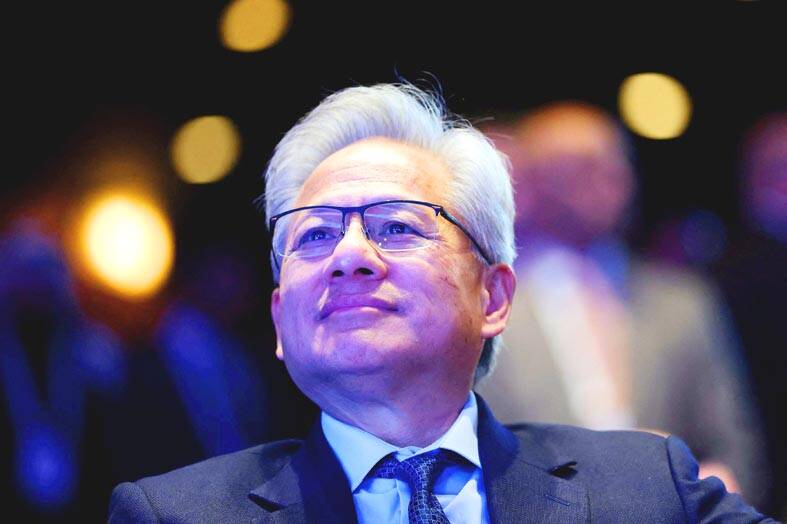TRADE WAR:
Nvidia’s expansion has faced challenges, with US restrictions on shipping advanced chips to China locking the company out of a massive market for its products
Nvidia Corp on Wednesday delivered a surprisingly strong revenue forecast and pushed back on the idea that the artificial intelligence (AI) industry is in a bubble, easing concerns that had spread across the technology sector.
The world’s most valuable company expects sales of about US$65 billion in the first quarter of next year — about US$3 billion more than analysts predicted.
Nvidia also said that a US$500 billion dollar revenue bonanza due in coming quarters might be even bigger than anticipated.

Photo: Reuters
The outlook signaled that demand remains robust for Nvidia’s AI accelerators, the pricey and powerful chips used to develop AI models.
Nvidia had faced growing fears that the runaway spending on such equipment was not sustainable.
“There’s been a lot of talk about an AI bubble,” Nvidia CEO Jensen Huang (黃仁勳) said on a conference call with analysts. “From our vantage point, we see something very different.”
The upbeat commentary sent Nvidia shares up about 5.4 percent in early trading yesterday before the markets opened in New York.
They had gained 39 percent this year through the close on Wednesday, leaving the company’s market value at US$4.5 trillion.
Nvidia’s results have become a barometer for the health of the AI industry, and the news lifted technology firms in Asia yesterday, with Taiwan Semiconductor Manufacturing Co (台積電) rising 4.3 percent in Taipei, Samsung Electronics Co gaining 5 percent and SK Hynix Inc adding 2.2 percent in Seoul.
Among broader markets, Taipei, Tokyo and Seoul were up between 1.9 percent and 3.2 percent.
Sydney, Singapore, Wellington, Mumbai, Bangkok and Jakarta were also well up, but Hong Kong pared gains to end flat, while Shanghai finished lower.
The company has more than US$500 billion of revenue coming over the next few quarters, Huang said last month.
Owners of large data centers would continue to spend on new equipment, because investments in AI have begun to pay off, he said.
Nvidia chief financial officer Colette Kress on Wednesday went further, saying the company would likely eclipse the US$500 billion target.
“There’s definitely an opportunity for us to have more on top of the US$500 billion that we announced,” she said on the conference call. “The number will grow.”
Nvidia’s third-quarter results also topped analysts’ estimates.
Revenue rose 62 percent year-on-year to US$57 billion in the period, which ended on Oct. 26. Earnings per share were US$1.30.
Analysts had predicted sales of US$55.2 billion and earnings per share of US$1.26.
Nvidia’s main data center unit had revenue of US$51.2 billion in the quarter, compared with an average estimate of US$49.3 billion.
Chips used in gaming PCs — once the company’s chief source of revenue — delivered sales of US$4.3 billion. That compared with an average estimate of US$4.4 billion.
However, Nvidia’s expansion has faced challenges. US restrictions on the shipment of advanced chips to China have largely locked Nvidia out of a massive market for its products.
“Our forecast for China is zero,” Huang said in a Bloomberg Television interview. “We would love the opportunity to be able to re-engage the Chinese market with excellent products.”
Some investors have also expressed concerns about the structure of the deals that Nvidia has struck with customers.
The transactions involve investments in start-ups such as OpenAI and Anthropic PBC, raising the issue of whether the pacts are creating artificial demand for computers.
Nvidia’s investment in OpenAI, which still has not been finalized, would provide a good return, Huang said.
Backing Anthropic would help establish ties with a company that has not been a big user of Nvidia’s technology, he added.
Additional reporting by AFP